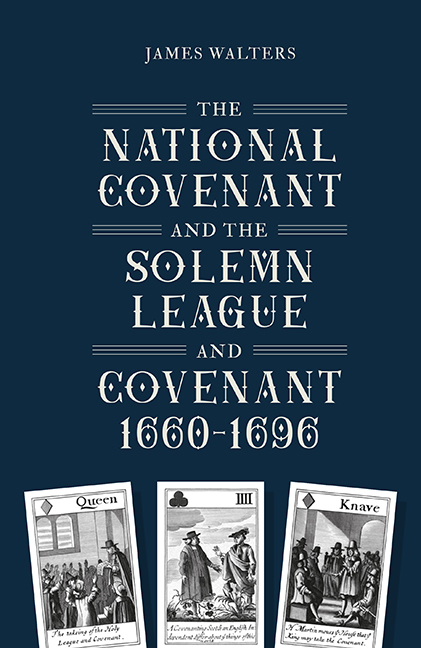Book contents
- Frontmatter
- Contentst
- List of Illustrations
- Acknowledgements
- Introduction
- 1 The 1638 National Covenant and the 1643 Solemn League and Covenant
- 2 1660: What Was to Be Restored?
- 3 The Act of Uniformity and the ‘Great Ejection’
- 4 Crisis and Toleration in the 1660s
- 5 Exclusion and Association in the Late Restoration Period
- 6 The Revolution of 1688 and the Association of 1696
- Conclusion
- Bibliography
- Index
- STUDIES IN EARLY MODERN CULTURAL, POLITICAL AND SOCIAL HISTORY
- Frontmatter
- Contentst
- List of Illustrations
- Acknowledgements
- Introduction
- 1 The 1638 National Covenant and the 1643 Solemn League and Covenant
- 2 1660: What Was to Be Restored?
- 3 The Act of Uniformity and the ‘Great Ejection’
- 4 Crisis and Toleration in the 1660s
- 5 Exclusion and Association in the Late Restoration Period
- 6 The Revolution of 1688 and the Association of 1696
- Conclusion
- Bibliography
- Index
- STUDIES IN EARLY MODERN CULTURAL, POLITICAL AND SOCIAL HISTORY
Summary
The National Covenant (1638) and the Solemn League and Covenant (1643) were originally documents that emerged in the context of religious warfare. They were structured by Scottish political and religious theories of presbyterianism and a right to resist arbitrary authority. The National Covenant was a means by which its authors hoped to cement the unity needed to resist reforms imposed on the Kirk by the regime of Charles I. The Solemn League and Covenant was an instrument to cement an alliance formed during the First English Civil War between the dominant Scottish faction loyal to the National Covenant and the English Parliament, which agreed to the reformation of the English and Irish churches in exchange for Scottish military support against the king. These terms were as much driven by military expediency as they were expressions of sympathy for the religious and constitutional position articulated in the Covenants.
Yet despite the nature of the Covenants as responses to these specific political crises, and their rigidly Scottish presbyterian origins, they functioned throughout the seventeenth century as living documents through which polemical writers considered contemporary debates around the entangled constitution of church and state in the British kingdoms. The Covenants were prisms through which people approached the issue of the relationship between church and state in a context where there were two churches, and two states. They were interpreted as a model for a constitution of church and state where the powers of the king and the government of the church were settled by law, and the people consensually bound to this constitution via solemn oath. While this constitution was never realised, the concept of a settlement of both royal authority and church government under the law, to be secured and defended on the basis of public subscriptions to oaths, re-emerged in the post-1688 Revolutionary settlement, and in the 1696 ‘Association’ by which this settlement was defended. This book will argue that the form and function of the Covenants were reconceived of in service to an emerging pluralistic vision of ‘Protestantism’. This was Protestantism in a broad sense, defined more by civic, political, and strategic concerns than ecclesiology, in effect, a civil religion, rather than the jure divino religion embodied in the Covenants.
- Type
- Chapter
- Information
- Publisher: Boydell & BrewerPrint publication year: 2022

